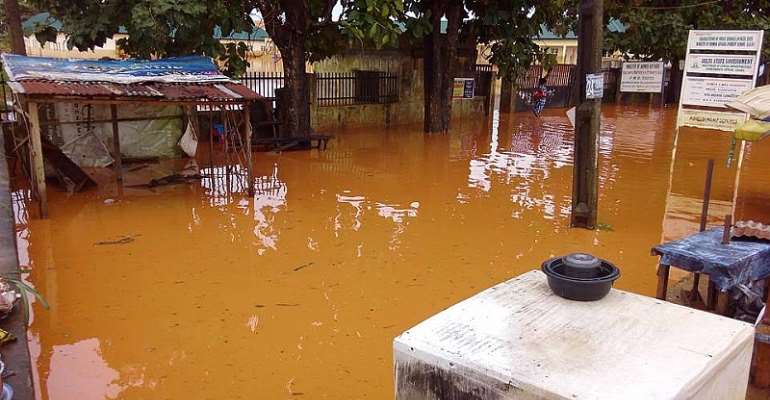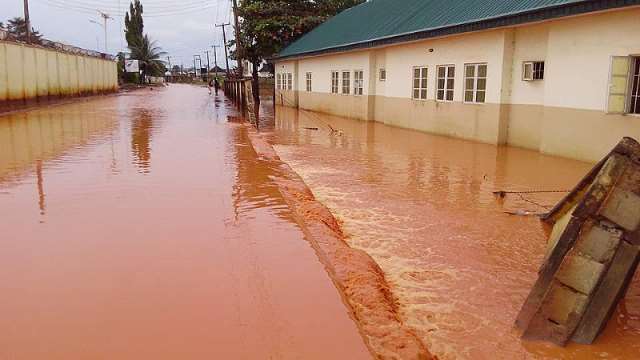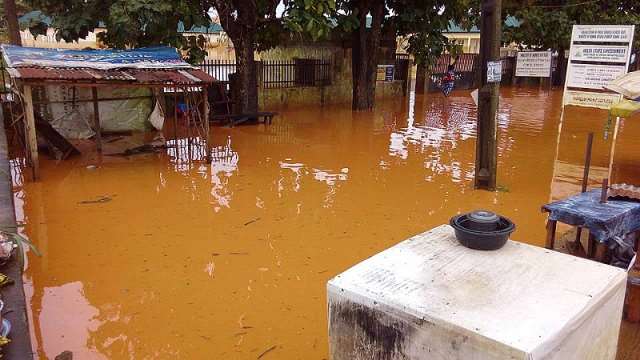FLOODING: Delta Government In Cheap Self Defense, Blame Residence

Eleven months counting after the Nigerian Society of Engineers (NSE), Asaba branch paid a courtesy visit on the Delta State governor, Ifeanyi Okowa, on 8 August 2017, towards mitigating the ugly challenges of flooding in Asaba, the State Capital Territory with the presentation of a Technical Report on Storm-Water Management and Control to him, the menace of flood is yet to be overcome.
Despite the storm control drainage being constructed by the present administration across the state, whenever it drops, it brings untold hardship to Deltans and residence.
Briefing journalists on 18th July 2018, the Commissioner for Works, Chief James Augoye, said unless residence stopped empting refuse into the drains, the effect of the flood would be more on them that lives around the area besieged by the flood.
Hear him: “from that Cornerstone junction down to almost the Legislative Quarters, you can see the high level of siltation as a result of refuse dump. Even the wipe holes that water is supposed to go through to the drains are been filled with refuse and that is creating serious problems for us”.
While continuing with the blame game, Chief Augoye, said if the situation continues, when they finally handover the roads to us, it therefore means that we are going to face a serious challenge”.
While some states are celebrating few minutes of complete water drain from their roads after it rains, the Works Commissioner was celebrating two hour after it poured, “And if you discovered what happened when the rain fell, two hours after the rain, the water was completely drained even when the construction has not been completed that is to tell you the effectiveness of the storm water drain which we are contrasting. If it can happen this way, it therefore means that when we complete the two storm water along the Asaba/Okpanam axis, it therefore means that the issue of flooding will be a thing of the past”.
While aligning with reporters that the closed drains are as a result of sands flowing into them from the adjoining streets, he argued “but the truth is that the drains are self-cleansing. They are so big to the extent that if you don’t have hard objects, the sand will flow easily to discharge but when you have hard objects like cellophane and other things that now holds the sands back, it will now lead to a build-up of sand and that is what you are seeing leading to siltation of our drains especially along the Okpanam area”.
In his words: “and so the refuse contribute 80 per cent to the siltation of drains in that axis of the roads because they are hard objects. Instead of the water carrying the sands along as it flows because of the snippy nature, these hard objects help because it does not dissolve and so when they are together, they act as block to the sand which leads to siltation from drains very quickly. While sand contribute, the hard objects helps it faster”, he added.
Areas affected when it rains include Direct Labour Agency (DLA) Road/Jesus Saves Road/Agric Road/Nnebisi Road/Edozie Okonkwo Street (Beside FMC), Junior Staff Quarters, Erhuvwu Club Road and Kingsley Emu Street within Phase IV, Okpanam Road, Mariam Babangida Road/WAEC Road/DBS Road, Ogbolu Onwuka (SSS Road), St. Brigid’s Road at Umuaji Junction, Eagle Square Area of Okpanam Road, Umuagu Quarters and Ogbe-Ilo Quarters.





